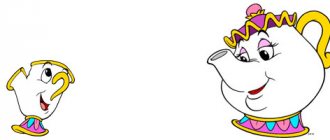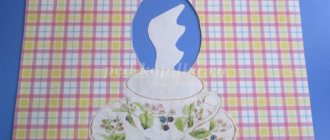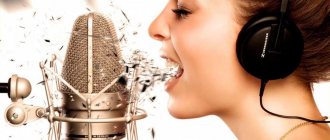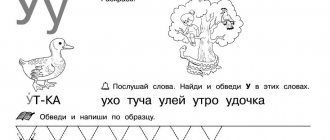Correct articulation of the sound “C”
To make the naughty “S” sound correctly, let’s build the following structure:
- The lips smile slightly.
- The teeth are clenched or spaced 1-2 millimeters apart.
- The tongue rests on the lower incisors. Its lateral parts are in contact with the molars at the top, and the back is curved.
- A groove is formed along the tongue, and air flows through it with strong pressure.
- The upper soft palate prevents it from entering the nasal cavity.
- The vocal cords are relaxed.
Happened?
The articulatory profile of the sound “C” looks like this:
The articulatory structure of the soft “S” differs from “S” in that the middle part of the tongue rises up, and the front part becomes flatter, while the groove is smoothed out.
Lesson 3
Automation of the sound [s] in syllables (intervocalic position) Development of articulatory motor skills Lips in a smile. The tongue is “grooved” inside the mouth. Arching of the back of the tongue upward while the tip rests on the gums of the lower incisors. Coordination of breathing, articulation and phonation “The fox teaches fox cubs to speak.” Pronouncing the syllable combinations ysy-ysy-ysy, asa-asa-asa, usa-usa-usa, isy-isy-isy, oso-oso-oso, asu-asu-asu, wasp-isy-asy on behalf of the Fox and fox cubs ( high and low voice with changing intonation). Development of phonemic perception - Name the place of sound in a syllable. The syllables are called sa, as, asa. Where is the sound [s] heard in the words fox, elephant, Barbos! Reading the syllables sa, so, sy Development of auditory memory and attention Fulfilling assignments. Get up from your chair, go to the table and take the fox. Follow instructions of 2-3 steps. - Take the donkey, put it on a chair and sit at the table. Take a fox, put him between the elephant and the dog; go to the chair and then sit down.
Defects in the pronunciation of the sounds “S” and “S”
If “С” and “Сь” are pronounced incorrectly, then this defect is called sigmatism (distortion of pronunciation) or parasigmatism (replacement with other sounds).
Sigmatism happens:
- labial-dental, when the lower lip blocks the air flow, creating a mixed sound of “S” and “F” (elephant - flon, table - ftol);
- interdental, in which the tongue lies on the teeth, and the clarity of the pronounced sound is distorted by a lisp;
- lateral, when the tongue turns to one side or does not touch the molars, and the air moves in the wrong direction, creating a squelching sound (the sled is slurping, the sled itself is slurping);
- nasal, in which air enters the nasal cavity and creates a nasal pronunciation.
Parasigmatism also comes in several types:
- toothed, with “S” replaced by “T” (dog - tobacco, juice - current);
- hissing, when instead of “S” the sound is “Sh” (Sasha - Shasha, sushki - shushki);
- with replacement by softness, in which hard sounds are pronounced as soft (bag - syumka, svoy - svoy);
- with a replacement based on voicing, this “S” sounds like “Z” (scoop - call, dump truck - zamozal).
The sequence of sound production in speech therapy
The algorithm for correctional work on the formation of correct sound pronunciation in speech therapy includes several stages in the following order:
Whether it be individual speech therapy classes for preschoolers with a specialist or sound production at home, sequential completion of all stages is mandatory.
In order for the delivered sound to delight you with its purity and stability, you need to work thoroughly and solve problems at each stage.
Let's start?
Preparatory stage
At the very beginning of working on correcting sound pronunciation, introduce your child to the problem sound: how it sounds on its own and in different words, how it is depicted as a letter, how to pronounce it correctly.
Perform breathing exercises. After all, correct breathing is the basis of sounding speech and directly affects the strength of the air stream, which, in turn, determines the clarity of sound with the correct articulation pattern.
Here are some breathing exercises:
Next, move on to articulatory warm-up. Let all the muscles of the speech apparatus prepare for productive work on sound production.
Lesson 1
Breathing exercises
"Harmonic". I. p. - stand straight, lower your arms. Place your palms on your tummy and take a deep breath through your nose. Hold your breath for 1-2 seconds. Exhale through your mouth. Development of exhalation force. Developing the correct direction of the air stream along the midline of the tongue
"Cold wind". Having drawn air into your lungs, blow forcefully through your lips extended forward with a tube. Bring the back of your hand to your mouth. You should feel a sharp, beating cold stream.
Exercises for lips and facial muscles
Game exercises
"Smile". “We are glad to meet a friend.” Stretch your lips in a smile to the limit and hold them in a tense position for some time. The teeth are closed. Repeat 3-4 times. "Cranky monkeys." Movements with closed lips to the right and left. (If you have difficulty, help with your index fingers.)
Exercises to flatten and strengthen the lateral edges of the tongue
"Track". Place your wide, spread tongue on your lower lip and hold it in this position for a count of 5.
“The tongue is looking for a crack in the fence.” Extending the spread tongue between the teeth and biting it. (Teeth marks should remain on the tongue.)
“The tongue is sleeping on the crib.” Descent of the back of the tongue. Press the tip of the tongue against the lower incisors and lower the back.
Note. In case of difficulty, ask the children to cough and yawn, while the soft palate involuntarily rises and the root of the tongue falls. You can interest children by offering to meet or say hello to the little tongue.
Development of phonemic awareness
Isolation of the sound [s] against the background of syllables and words among sounds that are distant in acoustic and articulatory characteristics.
Game "Catch the Sound". The child should clap his hands when he hears the sound [s]. First, the teacher pronounces the sounds [l], [s], [r] [s], [l], [m], [b], [s], then the syllables la, so, ro, su, pa, su, sy , ba.
If a child identifies a sound from a sound or syllabic series, the words poppy, cheese, souk, shelf, son, bun, lamp, catfish are given.
Development of the voice and switchability of the organs of the articulatory apparatus
Pronunciation of vowel sounds with changes in the strength and pitch of the voice.
“Let’s sing a lullaby to the doll”: a-a-a-a-a-a-a-a-a. “Teeth hurt”: o-o-o “Steam whistle”: o-o-o.
Sound production stage
How to make the sound “S”? There are several ways to set “C”:
Let's consider all these options in more detail.
Imitation performance
Take a mirror and show your child what position the tongue and lips should be in to produce the desired sound.
So that it doesn't look like a boring school lesson, let the tongue be a ship in which the wind-air current inflates the sails for a long voyage :)
The game form of organizing speech therapy classes is the most productive. Imaginative perception significantly speeds up the correction process and brings us closer to the cherished goal.
Place your baby’s hand on his mouth so that he feels the coolness of the exhaled air when pronouncing “S”.
Illustrations, cards, layouts and other visual material will help the child grasp the essence and will not let him get bored.










